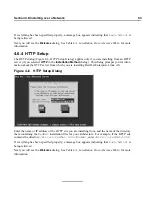
106
Chapter 6:Linux Virtual Server Overview
Distributes each request sequentially around the pool of real servers. Using this algorithm, all
the real servers are treated as equals without regard to capacity or load. This scheduling model
resembles round-robin DNS but is more granular due to the fact that it is network-connection
based and not host-based. LVS round-robin scheduling also does not suffer the imbalances
caused by cached DNS queries.
Weighted Round-Robin Scheduling
Distributes each request sequentially around the pool of real servers but gives more jobs to
servers with greater capacity. Capacity is indicated by a user-assigned weight factor, which is
then adjusted upward or downward by dynamic load information. See Section 6.3.2, Server
Weight and Scheduling for more on weighting real servers.
Weighted round-robin scheduling is a better choice if there are significant differences in the
capacity of certain real servers in the pool. However, if the request load varies dramatically, the
more heavily weighted server may answer more than its share of requests.
Least-Connection
Distributes more requests to real servers with fewer active connections. Because it keeps track of
live connections to the real servers through the IPVS table, least-connection is a type of dynamic
scheduling algorithm, making it a better choice if there is a high degree of variation in the request
load. It is best suited for a real server pool where each member node has roughly the same
capacity. If a group of servers have different capabilities, weighted least-connection scheduling
is a better choice.
Weighted Least-Connections (default)
Distributes more requests to servers with fewer active connections relative to their capacities.
Capacity is indicated by a user-assigned weight, which is then adjusted upward or downward
by dynamic load information. The addition of weighting makes this algorithm ideal when the
real server pool contains hardware of varying capacity. See Section 6.3.2, Server Weight and
Scheduling for more on weighting real servers.
Locality-Based Least-Connection Scheduling
Distributes more requests to servers with fewer active connections relative to their destination
IPs. This algorithm is designed for use in a proxy-cache server cluster. It routes the packets
for an IP address to the server for that address unless that server is above its capacity and has a
server in its half load, in which case it will assign the least loaded real server to the IP address.
Locality-Based Least-Connection Scheduling with Replication Scheduling (R)
Distributes more requests to servers with fewer active connections relative to their destination
IPs. This algorithm is also designed for use in a proxy-cache server cluster. It differs from
Locality-Based Least-Connection Scheduling by mapping the target IP address to a subset of
real server nodes. Requests are then routed to the server in this subset with the lowest number
Содержание ENTERPRISE LINUX AS 2.1 -
Страница 1: ...Red Hat Enterprise Linux AS 2 1 The Official Red Hat Enterprise Linux AS Installation Guide ...
Страница 8: ...viii ...
Страница 14: ...xiv Introduction ...
Страница 15: ...Part I Installing Red Hat Enterprise Linux AS ...
Страница 16: ......
Страница 26: ...26 Chapter 1 Steps to Get You Started ...
Страница 30: ...30 Chapter 2 System Requirements Table ...
Страница 80: ...80 Chapter 3 Installing Red Hat Enterprise Linux AS ...
Страница 94: ...94 Chapter 4 Installing Red Hat Enterprise Linux AS via Text Mode ...
Страница 95: ...Part II Configuring Red Hat Enterprise Linux AS ...
Страница 96: ......
Страница 100: ...100 Chapter 5 Introduction ...
Страница 114: ...114 Chapter 6 Linux Virtual Server Overview ...
Страница 153: ...Part III Appendixes ...
Страница 154: ......
Страница 156: ...156 Appendix A Additional Resources for LVS Clustering ...
Страница 160: ...160 Appendix B A Sample etc sysconfig ha lvs cf File ...
Страница 162: ...162 Appendix C Removing Red Hat Linux ...
Страница 168: ...168 Appendix D Getting Technical Support ...
Страница 178: ...178 Appendix E Troubleshooting Your Installation of Red Hat Enterprise Linux AS ...
















































